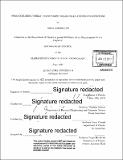Demonstrating visibly transparent solar cells and photodetectors
Author(s)
Jungbluth, Anna, S.B. Massachusetts Institute of Technology
DownloadFull printable version (6.646Mb)
Other Contributors
Massachusetts Institute of Technology. Department of Physics.
Advisor
Vladimir Bulović and Janet Conrad.
Terms of use
Metadata
Show full item recordAbstract
The fabrication of inorganic semiconductor devices, such as silicon solar cells and photodetectors, is despite significant research still expensive and energy intensive. Especially for solar cells, high upfront costs are a limiting factor for large-scale fabrication and implementation. Organic semiconductors have attracted increasing attention over the last decade for their optoelectronic properties and potential applications in electronics and photonics. The ease of processing, light weight and low cost of organic semiconductors provides the opportunity for inexpensive, large-scale fabrication. In addition, the mechanical flexibility and bandgap tunability of organic materials enables the fabrication of flexible and semi-transparent organic solar cells and photodetectors that could be installed on any surface and integrated into windows and displays. This thesis demonstrates visibly transparent solar cells and photodetectors, fabricated using the organic materials tetraphenyldibenzoperiflanthene (DBP) and chloroaluminum phthalocyanine (CIAlPc). We fabricated our devices through spin-coating, thermal evaporation and sputtering and characterized the performance of our devices by measuring the current-voltage behavior, external quantum efficiency and visible transparency. Our devices demonstrate an average visible transparency of around 56%, power conversion efficiencies between 0.53% and 1.36% and specific detectivities on the order of 1011 to 1012 Jones. These values are comparable to results found in literature. The primary goal of this work is to highlight the potential of organic materials for transparent electronics and to provide a detailed overview of the fabrication and characterization techniques needed to advance research in this area.
Description
Thesis: S.B., Massachusetts Institute of Technology, Department of Physics, 2017. Cataloged from PDF version of thesis. Includes bibliographical references (pages 62-66).
Date issued
2017Department
Massachusetts Institute of Technology. Department of PhysicsPublisher
Massachusetts Institute of Technology
Keywords
Physics.